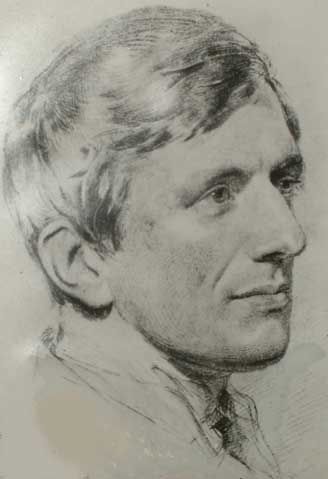
Thank you for all of your comments on my France trip! I'll definitely be following your advice!
Before I move on to John Ruskin's interpretation of Gothic architecture, I'd like to spend a bit more time talking about the Medieval/Gothic revival of the early 19th century that Augustus Welby Pugin was such an important part of.
If you're a church history buff, you've probably heard of John Henry Newman (pictured right), the Anglican cleric who converted to Roman Catholicism after falling in love with the church's apostolic heritage (he later became a cardinal). Before his conversion, Newman was an extremely influential member of the Oxford Movement that aspired to return the Church of England to its Roman Catholic roots. Newman and Pugin were both heavily involved in a religious movement that idealized the Middle Ages for the spiritual awareness they believed the people of the time possessed.
During Pugin and Newman's time, Gothic Revival was closely connected to spiritual renewal, and a number of sermons were preached on the subject. Some portrayed Gothic architecture in a positive light, some did not. For example, a rather inflammatory address on Gothic Architecture entitled "The "Restoration of Churches" is the Restoration of Popery!" was given by Reverend Francis Close of Cheltenham in 1844(186).
When Newman decided to have the Chapel of St. Mary and St. Nicholas constructed in the Gothic style in 1835, it created a bit of a stir. This was prior to his conversion to Catholicism, but Newman was still a controversial figure. And while Newman did not join the Camden society--Pugin's circle of Gothic architects--he praised the style, and started his own group, the Oxford Society for Promoting the Study of Gothic Architecture (190).
Although Newman and Pugin were initially close friends, they ultimately had a falling out over (what else) the importance of Gothic architecture. Newman eventually came to beleive that, while Gothic architecture represented the perfect style for the Middle Ages, and that it should be preserved, it was not necessarily the best design for the 19th century (206). In the end, he rejected the notion that only one style could truly glorify God. This infuriated Pugin, who felt betrayed by Newman.
The lasting contribution of the early 19th century Gothic revivalists was their belief that one's moral and spiritual convictions are reflected (and informed!) by the work one produces. Augustus Welby Pugin wrote in defense of Gothic architecture that "the belief and manners of all people are embodied in the edifices they raised"(186). We will see that this sentiment had a powerful influence on the works of both William Morris and John Ruskin, although they would later re-interpret it in a more secular light. Morris himself saw Pugin's revival in Marxist terms: "the Gothic Revival was and is really connected with the general progress of the world, with...aspirations towards freedom"(206). In contrast, Pugin's desire was for the restoration of the Middle Ages, and through it "the star-gilt world that lived in his imagination"(206).
Source consulted: James Patrick, "Newman, Pugin and Gothic" Victorian Studies, Vol. 24, No. 2 (Winter, 1981): 185-207
Image courtesy wikimedia commons.
Thursday, April 24, 2008
Gothic Revival and Spirituality: John Henry Newman and AWN Pugin
Posted by
Margaret
at
9:40 AM
![]()
![]()
Labels: architecture, medieval, philosophy
Subscribe to:
Post Comments (Atom)


2 comments:
Do you think that the lack of the Christian underpinnings in the Arts and Crafts movement, that existed with Pugin in his Gothic revivalism, contributed to the Arts and Crafts short life?
Thank you for the comment, and welcome!
It's an interesting question, and one that I've often wondered about myself.
I'm not sure if I would say that the Arts and Crafts movement had a short life in comparison to other movements. Gothic revivalism is about as alive today as A&C is. That being said, I think religious underpinnings certainly give additional life to any social/political/artistic movement.
Post a Comment